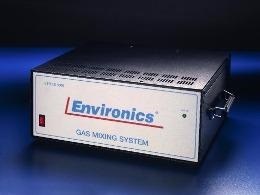Gas chromatography is an innovative technique that uses an inert carrier gas for separating and quantitating vaporized compounds. It is based on principles similar to column permeation chromatography, where a sample is passes through a stationary porous structure after being dissolved in a mobile phase.
Compounds are classified and quantified in the time it takes for them to leach from the permeable column. This factor is decided by a number of characteristics, including hydrodynamic behavior, molecular weight and concentration in the mobile phase.
The differentiating factor between standard chromatographic methods and gas chromatography and is rather than using a fluid as a mobile phase a vapor is used, and for the stationary phase a liquid as opposed to a solid is used.

Image Credit: Environics, Inc.
How Does Gas Chromatography Work?
Non-reactive gases are used as a carrier for vaporized molecules of interest including helium (He) and/or hydrogen (H). This gaseous mixture is fed through the column of a gas chromatograph, which is made up of a microscopic fluidic membrane and an static, solid substrate.
This column separates vapors based on their mechanical properties as well as their affinity with the stationary fluid. The flow-through rates of the sample’s elemental parts can be used for compound detection, quantitation, identification and purification.
Elution in gas chromatography is monitored electronically by placing a detector at the outlet stream of the permeable column. This measures the retention time (tR) of compounds to qualitatively identify their adsorption characteristics with packing media of specific chemical compositions.
Challenges in Gas Chromatography
Calibration of detectors remains one of the reoccurring challenges in gas chromatography today. Several detector types are incorporated into gas chromatographs such as mass spectrometers, thermal conductivity detectors and flame ionization detectors.
The functionality of each of these systems is based on distinct principles and must be calibrated to detect tiny concentrations of gas in real-time with high selectivity.
Specialized gas mixers are necessary to maintain the performance of gas chromatography calibration to produce a test mobile phase with desirable concentrations. This relies upon the application area, but conventional gas chromatography studies necessitate mass accuracy levels to the parts per million (ppm) and parts per billion (ppb) range.
Mixers must also have the capacity to match the appropriate thermal mass flow rate and pressure ranges of test conditions.
Gas Chromatography Solutions from Environics
With decades of experience in the production of gas mixers, diluters and dividers for gas chromatography calibration, Environics Model 4000 systems are as much as ten times more accurate than standard thermal mass flow meters. What’s more, is that customization for the properties of the gases of interest is possible.
This facilitates reliable detection of compounds of interest and preparatory observation of concentration levels, while determining an accurate and repeatable calibration curve.
Our Zero Air Generators (ZAG) have been developed for ultimate flexibility and low-cost calibration of gas chromatographs. They can supply a continuous stream of contaminant-free air at flow rates of 20 liters per minute (SLPM) and pressures of 30 psi either using an existing compressed air source or as a stand-alone system.
Environics range of systems for gas chromatography calibration includes:
- Series 4000 Multi-Component Gas Mixing System.
- Series 4020 Computerized Gas Mixing and Dilution System.
- Series 4040 Gas Dilution System.
- Series 7000 Stand-Alone ZAG.
For further information about Environics products or services for gas chromatography applications, please do not hesitate to get in touch.

This information has been sourced, reviewed and adapted from materials provided by Environics, Inc.
For more information on this source, please visit Environics, Inc.